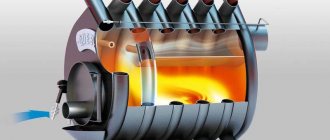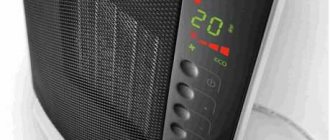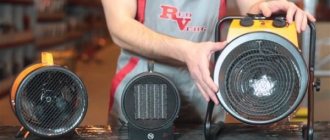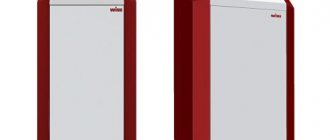During the cold season, many people spend a decent amount of time in unheated garages and outbuildings such as barns.
To make your stay as comfortable as possible, you should consider purchasing equipment such as a heater.
There are quite a lot of similar devices on sale today - they differ from each other in operating principle, overall dimensions, fuel used and a number of other parameters.
To shop for the most suitable equipment, read our review of the best garage heaters.
Rating of the TOP 10 best garage heaters for 2021-2022
| TOP 3 best garage heaters by price/quality for 2021-2022 | ||
| 1 | Ballu BIH-AP4-1.0 | Find out the price |
| 2 | RESANTA TVK-2 | Find out the price |
| 3 | Solar gas GII-2.9 | Find out the price |
| TOP 3 best infrared heaters for the garage | ||
| 1 | Ballu_BIH-LM-15 | Find out the price |
| 2 | Almac IK8 | Find out the price |
| 3 | Ballu BIH-L-3.0 | Find out the price |
| TOP 2 best heat guns for the garage | ||
| 1 | RESANTA TEPK-2000K | Find out the price |
| 2 | Ballu BHDP-20 | Find out the price |
| TOP 2 best oil heaters for garages | ||
| 1 | Electrolux EOH/M-6157 | Find out the price |
| 2 | RESANTA OMM-7N | Find out the price |
Heating with solid fuel
A widely used garage heating option. Solid fuel boilers are completely autonomous and at the same time economical. The following can be used as fuel:
- Used oil (waste oil). It's cheap and requires little fuel. But they are fire hazardous; during operation they emit huge volumes of carbon monoxide.
- Coal. Cheap and cheerful, but quite dirty.
- Firewood. The cheapest fuel.
The fuel is burned in a compatible boiler. The most economical is pyrolysis. One load of fuel in it is enough for 8 – 12 hours of active heating. In combination with a liquid circuit with coolant, this heating method will allow you to heat the garage from the inside to a comfortable temperature of 15 - 18 degrees and maintain it for 5 - 10 hours.
Or you can simply install a “potbelly stove” and heat the garage with it. This will be the best option if its area does not exceed 20 - 30 m². But you will additionally need to install a chimney and a ventilation system (at least with natural air flow).
To make the best choice, you need to understand what types of solid fuel boilers there are, and which option is better suited for certain operating conditions. In a special article we will talk about this in detail, and also present a rating of solid fuel heating boilers for a private home.
Which garage heater should you choose?
When choosing a heater, special attention should be paid to the area of the room for which it is purchased:
- For small garages, the best option would be heat fans, which heat up quickly enough and immediately fill the room with warm air. For example, RESANTA TEPK-2000K (2 kW).
- For larger garages (from 20 sq.m.), it is better to purchase an infrared heater. For example, Ballu BIH-L-3.0.
- For large hangars that house multiple vehicles, the Ballu BHDP-20 is the best option.
- If you want to save money, it is better to purchase a gas heater. They are considered more economical and safe. Among those presented is Electrolux EOH/M-6157.
Oil furnaces
The room heats up much faster when using waste oil.
One spark is enough to ignite the flame. And the heat transfer is many times higher. However, this is also an unsafe option. Usually oil is burned in small ovens that you can make yourself. But even if such a potbelly stove (or small boiler) is reliable, liquid fuel may fail. In pursuit of cheapness, only used oil is used for heating, which must first be drained and allowed to settle. Of course, no one carries out any additional cleaning procedures. However, water accidentally getting into the oil or a drop of antifreeze on the walls of the boiler can cause dangerous consequences. When the oven is in operation, hot oil may begin to “shoot” in different directions. These fiery sparks can seriously burn and cause a fire. Sometimes owners take such a risk, because buying diesel fuel for heating is expensive. In this case, you need to keep an eye on the stove in the garage all the time.
Basic criteria for choosing a heater for a garage
Oil, gasoline and other flammable liquids are typically stored in the garage. Therefore, when choosing a heater, special attention should be paid to safety.
Oil-based ones are considered the safest, but they take a long time to warm up and heating the room to normal temperature will also take a long time.
Heat guns will do the job much faster. They are equipped with a coil that heats up in a matter of seconds and a fan that immediately begins to distribute heat in the room.
However, such heaters are less safe and require proper location: there should be no flammable substances nearby, and the heaters themselves cannot be covered with anything.
In any case, each heater must have the necessary certificates confirming the safety of the unit.
An important characteristic is the power consumption of the heater; in most of them at maximum operating mode it is 2000 W.
Water batteries
This type of heating is very labor-intensive to organize.
Already at the planning stage you will need to think through a lot of details. Indeed, in addition to the heat source, you need a system of pumps and pipes through which hot water will circulate. And this will inevitably entail the purchase of an expansion tank with batteries. In addition, plain water cannot be used. It must contain antifreeze to prevent freezing in winter. Equipping your garage with water heating only makes sense if you plan to spend a lot of time here. Or it is a structural part of a house that already has a central heating system. Then the garage room can be equipped with a water heater for uniform distribution of warm air.
Customer Reviews
Yulia M.
Ballu BIH-AP4-1.0
Careful. Almost invisible under the ceiling. We took it to maintain heat in the living room of a country house. Pleasant sensations. So far we're happy. Disadvantages: The rotating mechanism has a large pitch, it is impossible to adjust it to the desired radius, I’ll say right away that it’s not critical. And I would like more description in the instructions. Comment: In principle, a normal heater, we bought it specifically for the off-season, and immediately bought a regulator for it. Heating is felt throughout the room, not just in spots, as from heating. The only thing is that when I bought it, I couldn’t find information about whether it can be used with stretch ceilings, we are planning to make ceilings, but I would like to clarify. I won’t say anything about power saving, because we’ve been using it for less than a month and the receipt for the electricity hasn’t arrived yet. I am attaching a photo, everything is temporarily connected. We will do repairs and handle everything more carefully.
Alexander P.
RESANTA TVK-2
Advantages: 1. Powerful flow of warm air, heats well. 2. Beautiful design, compact size, and has a carrying handle. 3. There is a rotation mode. 4. Temperature and power can be adjusted. 5. There is protection against capsizing and overheating. Disadvantages: 1. After 2 weeks of operation, clicks appeared that occur when the direction of rotation of the heater changes. It started to get tense. If it doesn’t stop straining or the clicking doesn’t stop, then I’ll take it in for repair) 2. There’s not enough separate button or switch to turn it on and off on the front panel. Turning it on and off using a button would be more convenient than turning the mode switch. 3. A dust filter probably wouldn’t hurt, but it’s not currently in fashion among manufacturers, and maybe it’s not necessary. Comment: Bought as additional heating for home under a computer desk standing by the window. It copes with the task. There was no smell either the first time it was turned on or the subsequent ones. PS: After using it several times, it stopped clicking on its own. Apparently something fell into place)
Alexander Nezvidsky
Solar gas GII-2.9
This heater heats just like a big expensive one, because the area of the ceramics and the gas outlet are the same, the whole difference is in the design and configuration, this heater does not have a gearbox (300-500) rubles and a hose 200 rubles, a regular gas one is suitable (one end We cut off the other one onto the gearbox and pull it onto the heater nozzle, I recommend squeezing it with a clamp for those especially nervous, although everything fits tightly anyway) it’s ready. The CO2 output is minimal and is safe with natural ventilation. I’m heating the garage, in an hour I can heat up 18 m/² to plus 16 with 0 outside the gate. Another 2 kW of wind helps with it in an hour 20 plus at 14 minus outside, it will still depend on the energy efficiency of your room, if you cannot achieve such indicators, think about insulating the room. By consumption: 18 liter composite cylinder with 14 liters of refill, enough for a week when using the heater 5-6 hours a day. Refilling 14 liters costs 430 rubles. A good thing
Valeria D.
Ballu BIH-LM-1.5
Very pleasant warmth, does not dry out the air! Large range of action. Three modes. Metal body. It's on 24/7 and doesn't overheat. Disadvantages: They brought the wrong one, but the S model, it is smaller in size. I'm afraid that its efficiency is less for the same power. It shines at night (but I'm used to it and it doesn't bother me) Short wire. I think it will heat 25 m2 only with good thermal insulation. Comment: I am writing a review specifically for this model (not S), since before ordering I had already purchased such a heater on the market. That’s why I wanted a second one, because I’m very pleased. I use it at my dacha, which is insulated “in places” - at night I just turn it on at 500 watts and direct it towards myself. I sleep under a cotton blanket and feel warm. The room is 12 meters high, if you turn it on at 1000 watts for a couple of hours, it’s hot. It’s convenient that you can just put it next to it and point it at yourself. This will not work with a convector and it heats worse even at a power of 2000 watts
Vladimir Rusakov
Almac IK8
Pros: The design is simple, laconic and at the same time attractive. There is a good choice of colors, for example, I have Almak IK 8 in wenge color, such a pleasant dark brown color, it looks very beautiful against the background of the wooden walls of the attic. There is also white, gold, silver and pine color. Good variety, you can choose one for any room. An interesting fastening in the form of a groove along the entire length and two pendants are inserted into it. Such a simple solution, a very practical heater i.e. you don’t need to measure the distance on the ceiling between the hangers: two hooks in the ceiling and then move the hangers under them and hang the heater. I bought it on the company’s website, on the official one, there are even detailed instructions and all the information on connection and operation. That is, even without seeing the product with your own eyes, you can fully evaluate it. Corresponds to the description. The color also matches. Everyone who comes to visit notices it and mistakes it for a lamp, but if it is turned on, it immediately becomes clear that it is a heater. Disadvantages: The fasteners did not fit into the groove right away. Perhaps there was an influx of paint or something else was in the way. I had to use a flathead screwdriver to pry it out a little there (made in Russia - finish it yourself with a hammer!). There were also minor abrasions on the case, although the packaging was not opened before me. Perhaps it’s the wenge color that gives away all the mistakes. In bright conditions the heaters would not be visible. Comment: There are the same heaters, only of a different size, but the design and everything is generally identical. You can choose one for any quadrature, I recommend taking a closer look at this option if you don’t want to pay dearly, but still need good performance.
Vlad Abramin
Ballu BIH-AP4-1.0
Advantages: 1) Convenience of mounting to the ceiling, and connecting to the wiring, everything is simple and clear. 2) Design Disadvantages: 1) Build quality (but maybe it’s just me, it started clicking, it was solved by disassembling the heater and squeezing some places with pliers); 2) Heating range across the width, and not just underneath. (Example: if you hang it over the bed, lengthwise, but closer to the feet, then after some time the legs will get hot, but the head will freeze; in length, it warms more or less normally, i.e., for example, if the bed is double, then and on the second part of the bed your feet will be quite warm) Comment: In general, it heats the area directly underneath perfectly, it also heats the sides along the length more or less, but not to the sides along the width. Additionally, I connected a Ballu BMT-1 thermostat to the heater. After about a few months, when it was working (heating, when the thermostat does not turn it off), something began to click inside, this does not affect the operation, but now you can’t leave it overnight because it’s loud, judging by the reviews it’s something with the expansion of the metal... In general, this can happen in all models of different companies. In comparison with an oil heater, this is of course better (the power is the same), both in terms of heating and convenience (it doesn’t take up too much space), but not the heating speed, which is slow. Especially if you come in winter and the house is icy, you need to wait at least an hour or two.
Andrey Karpovich
RESANTA TEPK-2000K
Advantages: — Small, takes up little space. — Quite a nice appearance — Lightweight — The cable, although a little short (about 1 meter), is quite enough for my needs — The case does not heat up — Easy to operate — 3 modes Disadvantages: — Lacks a timer — Weak flow Comment: At the time of writing I've been using it for 5 days now, I'm happy with everything. I bought it to heat a loggia (4 sq/m) since it is not insulated. Such an area is heated to a comfortable/room temperature in 15-20 minutes, taking into account that the approximate temperature in the room is +4 - +5. Please note, if you need to heat a room where the temperature is sub-zero or close to zero, then this mini-gun is unlikely to cope with this task, I advise you to take a more powerful model. Initially I didn’t expect much from a budget model, but in the end this model is quite enough for my modest needs
Vova B.
Electrolux EOH/M-6157
Advantages: New technology with accelerated heating. The surface is protected from mechanical damage. It has an interesting appearance, I would say even somewhat futuristic thanks to the round elements, built-in rollers for movement. This is the third year that this radiator has warmed the living room in the evenings and the children's room at night, a very positive impression. The oiler can work for hours without stopping or overheating and I can trust it, thanks to the presence of several safety levels at once. Well-thought-out wheels and a convenient handle allow the radiator to be moved between rooms in a matter of seconds, and in the summer it does not take up much space in the pantry, and the cord is hidden in the body of the radiator itself.
Nikolay S.
RESANTA TVK-2
Advantages: Low price, quickly warms up the room, 90° rotation, ceramic heating elements Disadvantages: The thermostat does not work well: at one adjustment level it can heat for a long time without turning off, or it may not turn on when it gets noticeably cold, as if there are tolerances of several degrees; The rotation around the axis does not stop when the mode is switched to the zero position, only disconnecting from the network Comment: As a heater - an excellent product: it heats quickly, consumes little, there was no smell As a climate control device - it is unlikely to be useful, it heats for a long time until it gets hot ( 24-25* at the heater level), then for a long time it does not warm up to noticeable coolness (20-21*)
Alexander S.
Ballu BHDP-20
Pros: I liked everything. The build quality is the size and most importantly how it works. I have several garages and it can be easily moved from one to another by the handle. The most important thing is that it works completely automatically. I set the desired temperature with the regulator and that’s it. It will turn on itself and turn off when the set temperature is reached. As soon as the temperature drops below the set one, it turns on again and so on until you turn it off or the diesel fuel runs out. Comment: When you turn it on in the garage, it is better to stick it out the door because the first exhaust will stink a little. Then it works in the room with virtually no odor. A 5-liter bottle is enough for a day to maintain the operating temperature in three garages - But not a whole day of work, but as needed .
Valentin N.
RESANTA OMM-7N
Advantages: Size, low power. Disadvantages: Lack of a shutdown button (there is one in the photo, in fact I don’t have one, only a light bulb, but they didn’t show it on the packaging either) Comment: Compact low-power oil heater, just what I was looking for for a balcony. Actual size 30x15x37 cm LxWxH No rollers, for me it doesn’t matter because... It is lightweight due to its compactness and has a handle for carrying. The power is enough to heat a small room (for me it’s a balcony) and at the same time not to overload the electrical wiring. I think it will be very suitable for those who were looking for a heater under the table, etc.
Leonard T.
Ballu BIH-L-3.0
Advantages: 1. The summer veranda is heated all over evenly, this is facilitated by the reflector located behind the heating lamp. 2. During use, it has not lost its attractive appearance: the steel case has not been deformed; The chrome grille, which protects against accidental contact with the heating element, has not rusted. Disadvantages: I had to go shopping to find a special telescopic tripod for installing the heater, because it was not included in the package. Comment: On the open veranda of my cafe you can not only have a tasty snack, but also warm up in cold weather; for this I installed a modern infrared heater, which gives visitors warmth from the moment it is turned on. I set the heating power depending on the air temperature to make it comfortable.
Gas heating
Gas heating is also a profitable option. But it is advisable to use devices that can run on methane. Such gas can be obtained directly from the home gas pipeline - it will cost 3-5 times less than buying cylinders with propane or a propane-butane mixture. The only drawback of heating using methane: filling gas cylinders can take several hours (specific to liquefaction).
Gas gun
Advantage of gas guns:
- Low cost. Simple models will cost only 2–3 thousand rubles.
- Fast heating. You can warm up a room to a comfortable temperature in 5–10 minutes, even in the most severe frosts.
- They consume a minimum of fuel. For 1 hour of operation in medium mode, up to 1 liter of gas will be required. Heating is cheaper than using any electric heating.
Prices for floor convectors
floor convector
But there are a lot of shortcomings, among which the key ones are:
- Gas guns are fire hazards. They heat with an open fire, and in a garage they are dangerous, because fuel and other petroleum derivatives classified as flammable materials are stored in it.
- With such heating, powerful ventilation is mandatory. An alternative is to install a gas gun with carbon monoxide exhaust to the outside. But the efficiency of the heating system in this case is reduced by more than 40%, which turns out to be no more profitable than the same electricity.
- Requires regular maintenance. The light-sensitive sensor must be cleaned of any burning, and the gas pipeline tubes must be cleared of blockages.
In summary, gas guns are effective, but they should be used with extreme caution. They are a fire hazard and release carbon monoxide into the garage itself.
A gas boiler
Without installing a water heating circuit, it makes no sense to use this heating method. Installation of the system will not be cheap, but subsequent heating will be profitable (it means paying only for the gas used). The average price for a boiler is from 10 thousand rubles (single-circuit, with minimum power). You should buy those models that are connected to cylinders (and not just to a centralized gas pipeline).
They are placed inside the garage, but a chimney is also installed to remove gas combustion products. The recommended volume of coolant in the liquid circuit is at least 10 liters per 10 m². The expansion tank is placed at the highest possible point - this way there is no need to install a pump to ensure forced circulation of the coolant.
In a special article we will talk about the types and features of operation, but most importantly, the rating of gas boilers for heating a private home will be presented. This information will be useful to all those who are currently puzzled by the choice of heating equipment.
Gas convectors
They are an analogue of electric heaters, but heating occurs by burning gas. Such devices are quite compact, easy to install, can be connected to cylinders (not all models), and consume little fuel. They cost, on average, 6–10 thousand rubles (depending on performance).
Western European experience
If you type the phrase “garage heating” in the search and look at pictures on English-language sites, you will not find any wood-burning or oil-fired stoves in Western European garages. How do local motorists warm themselves:
- electric portable heaters;
- infrared hanging heaters;
- air heating units (heaters).
The suspended air heating unit does not take up useful space in the garage
We have already discussed the first 2 options above. The third method is also far from new: water heated in the boiler passes through a radiator, blown by a powerful axial fan. Ideally, the unit is suspended from the ceiling and distributes hot air throughout the room.
The advantages of this option are compactness, heating speed and the possibility of air conditioning in the summer (cooled water is sent to the radiator instead of heated water).
Heater made from a car radiator
There is one downside - increased costs for equipment, because the coolant must be heated in the boiler and supplied through pipes to the heater. But if the garage is attached to a private house, then the problem is easily solved by connecting the radiator to the building’s water heating system.
Western European experience
If you type the phrase “garage heating” in the search and look at pictures on English-language sites, you will not find any wood-burning or oil-fired stoves in Western European garages. How do local motorists warm themselves:
- electric portable heaters;
- infrared hanging heaters;
- air heating units (heaters).
The suspended air heating unit does not take up useful space in the garage
We have already discussed the first 2 options above. The third method is also far from new: water heated in the boiler passes through a radiator, blown by a powerful axial fan. Ideally, the unit is suspended from the ceiling and distributes hot air throughout the room.
The advantages of this option are compactness, heating speed and the possibility of air conditioning in the summer (cooled water is sent to the radiator instead of heated water).
Heater made from a car radiator
There is one downside - increased costs for equipment, because the coolant must be heated in the boiler and supplied through pipes to the heater. But if the garage is attached to a private house, then the problem is easily solved by connecting the radiator to the building’s water heating system.
Fan heater - a simple and cheap option ↑
The design of the device is very simple, which ensures its reliability
When heating a garage with electricity, a fan heater is most often chosen. This is due to its mobility (the ability to install anywhere) and low cost. The equipment operates according to the following principle. The spiral or heating elements, which act as a heat exchanger, are heated by electricity. The fan draws air from the room and circulates it between heated elements. The air is heated by heating elements and enters the garage. Typically, a fan heater has two heating stages, which are characterized by power: 1 and 2 kW. The advantages of a fan heater as a method of heating a garage with electricity include:
Electricity
Heating with an electric boiler is a rather expensive solution to the heating problem for a garage. If there is no alternative type of fuel, then it is better to use electrical appliances (convectors, fans, heat guns, UFO heaters - described in detail above).
When using electric heating equipment indoors with open heating elements (coils, heating elements), it is necessary to remove flammable and combustible materials (fuels, lubricants, solvents, paints, tow, etc.) from the garage.
Advice
To reduce heating costs, the owner is recommended to insulate the outside walls and ceiling of the garage, having previously sealed all the cracks and holes. For thermal insulation of walls, you can use foam sheets, and expanded clay for the ceiling and floor. The use of mineral wool slabs will require subsequent waterproofing
A properly selected garage heating system will not only ensure a comfortable temperature in the room, protect the enclosing structures from dampness, but also prevent the development of corrosion on the metal parts of the car, which is detrimental to equipment.
Basic requirements for electrical wiring
There are certain requirements regarding electrical wiring in garages. So for a major garage they use closed-type wiring.
When laying wires along walls, they must be insulated.
This can be done using boxes made of metal or plastic.
Exposed wiring is suitable for metal garages.
For exposed wiring, prepare flat wires. These include APPV , PPV , APPR .
They are attached to the wall using metal brackets.
Insulating boxes are placed on top of the wires. They need to be fastened with screws. The optimal distance between staples is about 0.5 m .
Strip the ends of the wires. Now they can be connected to the socket terminals.
When choosing wires , consider several important points:
- Calculate the cable cross-section taking into account the power of the devices that will operate in the garage. Now multiply the total power value by 1.2. After this, select the appropriate cable cross-section .
- Under no circumstances use wires with aluminum conductors, as they are often subject to mechanical damage.
- It is better to buy a cable with a reserve. The length of the wires when connecting to sockets and panels should be 10-15 cm greater than .
- Think about the number of outlets in your garage. In any case, you need to install at least 2 pieces. One of the sockets is needed to connect an electrical appliance, and the second is for an extension cord.
- It is necessary to provide switches for the inspection pit and the main lighting of the garage.
Read about how to make racks, shelves, a workbench and a car lift in your garage.











